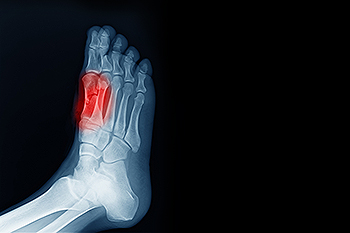
Sesamoiditis is an irritation of the two sesamoid bones that are located beneath the first metatarsal head of the foot. It leads to pain that can be particularly bothersome during activities like walking or running. These tiny bones, each about the size of a kernel of corn, play a significant role in foot movement. They can become painful due to trauma, foot structure changes, or repetitive stress. Sesamoiditis is often seen in dancers, runners, and those who frequently wear high heels. Symptoms can include localized pain beneath the big toe, swelling, and tenderness that worsens with pressure. Diagnosis typically involves a clinical evaluation by a podiatrist, sometimes supported by imaging tests to rule out fractures or other conditions. Treatment focuses on reducing pressure on the sesamoids through footwear modifications, including supportive shoes and custom orthotics. If you have pain under the big toe, it may be related to the sesamoid bones, and it is suggested that you schedule an appointment with a podiatrist for an exam and treatment.
Sesamoiditis is an unpleasant foot condition characterized by pain in the balls of the feet. If you think you’re struggling with sesamoiditis, contact one of our podiatrists of Nassau Foot & Ankle. Our doctors will treat your condition thoroughly and effectively.
Sesamoiditis
Sesamoiditis is a condition of the foot that affects the ball of the foot. It is more common in younger people than it is in older people. It can also occur with people who have begun a new exercise program, since their bodies are adjusting to the new physical regimen. Pain may also be caused by the inflammation of tendons surrounding the bones. It is important to seek treatment in its early stages because if you ignore the pain, this condition can lead to more serious problems such as severe irritation and bone fractures.
Causes of Sesamoiditis
- Sudden increase in activity
- Increase in physically strenuous movement without a proper warm up or build up
- Foot structure: those who have smaller, bonier feet or those with a high arch may be more susceptible
Treatment for sesamoiditis is non-invasive and simple. Doctors may recommend a strict rest period where the patient forgoes most physical activity. This will help give the patient time to heal their feet through limited activity. For serious cases, it is best to speak with your doctor to determine a treatment option that will help your specific needs.
If you have any questions please feel free to contact our offices located in Oceanside, Franklin Square, and East Norwich, NY . We offer the newest diagnostic and treatment technologies for all your foot and ankle needs.
